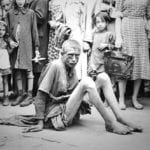 Weird Stuff
Weird Stuff  Weird Stuff
Weird Stuff  Our World
Our World 10 Ways Your Christmas Tree Is More Lit Than You Think
 Movies and TV
Movies and TV The 10 Coolest Stars to Set Sail on The Love Boat
 History
History 10 Things You Didn’t Know About the American National Anthem
 Technology
Technology Top 10 Everyday Tech Buzzwords That Hide a Darker Past
 Humans
Humans 10 Everyday Human Behaviors That Are Actually Survival Instincts
 Animals
Animals 10 Animals That Humiliated and Harmed Historical Leaders
 History
History 10 Most Influential Protests in Modern History
 Creepy
Creepy 10 More Representations of Death from Myth, Legend, and Folktale
 Technology
Technology 10 Scientific Breakthroughs of 2025 That’ll Change Everything
 Weird Stuff
Weird Stuff Ten Bizarre Facts About The Doge Meme
 Our World
Our World 10 Ways Your Christmas Tree Is More Lit Than You Think
 Movies and TV
Movies and TV The 10 Coolest Stars to Set Sail on The Love Boat
Who's Behind Listverse?

Jamie Frater
Head Editor
Jamie founded Listverse due to an insatiable desire to share fascinating, obscure, and bizarre facts. He has been a guest speaker on numerous national radio and television stations and is a five time published author.
More About Us History
History 10 Things You Didn’t Know About the American National Anthem
 Technology
Technology Top 10 Everyday Tech Buzzwords That Hide a Darker Past
 Humans
Humans 10 Everyday Human Behaviors That Are Actually Survival Instincts
 Animals
Animals 10 Animals That Humiliated and Harmed Historical Leaders
 History
History 10 Most Influential Protests in Modern History
 Creepy
Creepy 10 More Representations of Death from Myth, Legend, and Folktale
 Technology
Technology 10 Scientific Breakthroughs of 2025 That’ll Change Everything
10 Heartbreaking Tales Of Faithful Dogs
Dogs are well-known as a human’s best friend. Some people may prefer cats, but if you want a pet that will show you affection and care whether you live or die, then a dog is the pet for you.
The loyalty which makes dogs such devoted friends is so strong that it can last unto death and beyond. Here are 10 stories of faithful dogs that will make you want to hug your best friend extra tightly.
10 Shep
In 1936, a shepherd in Montana became ill in the field and had to be rushed to the hospital. His dog, Shep, refused to be separated from his owner and followed the man, whose identity is unknown, to the hospital. While Shep waited for his master at the hospital doors, he was fed by a local nun. Unfortunately, the shepherd died.
When the man’s body was carried to the local train station to be transported home, Shep followed. Workers at the station remember the dog whining as the casket was loaded onto the train and sped away from the faithful dog.
For the next five years, Shep remained by the train tracks. As each train arrived (around four trains a day), he would carefully examine each person who got off as if searching for his master. Shep became famous because of his long vigil and was fed by the staff at the station. As he aged, he became deaf and failed to hear an approaching train. It struck and killed the loyal dog.[1]
Shep now has a bronze statue set up in Fort Benton to recognize his patient wait to be reunited with a friend who would never return.
9 Capitan
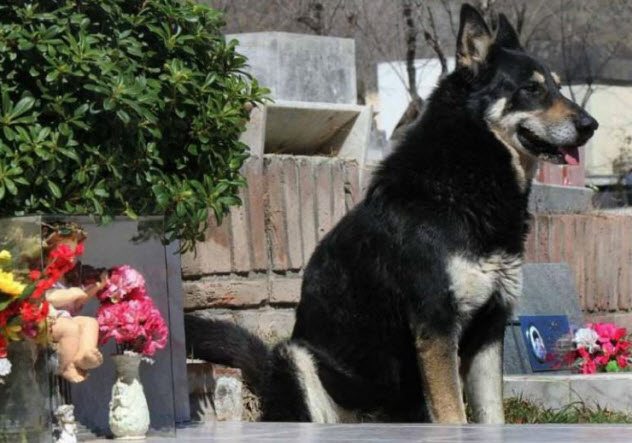
When Manuel Guzman died in 2006, his beloved dog, Capitan, disappeared from the family home. No one saw the dog for a week until he turned up at his master’s grave. The family had never taken Capitan to the site, so it is a mystery as to how he found Guzman’s grave.
Now when the Guzman family visits the graveyard every Sunday, they go to see Martin’s resting place and to check that Capitan is doing well. They had tried to take Capitan home several times after he first went to the grave, but he escaped to return to his owner’s side.
Sometimes, the dog will leave the graveyard to go to the family home. But he always returns at night to rest beside his master. The staff at the cemetery has taken over the task of feeding the loyal dog. They say that he will wander around the site during the day but lies down on his master’s grave at 6:00 PM sharp. As of today, Capitan is still waiting for his master.[2]
8 Gelert
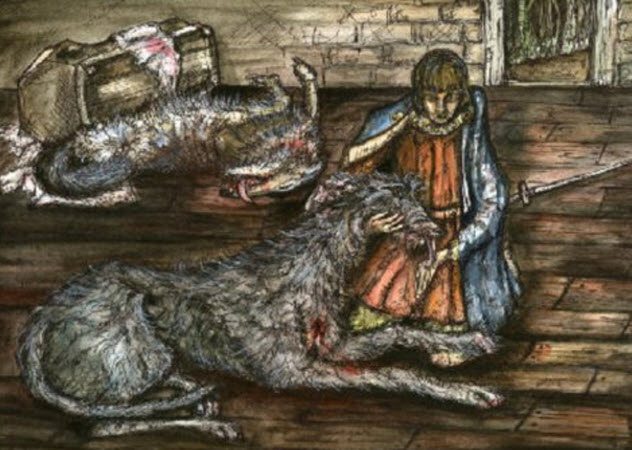
In the 13th century, legend has it that Prince Llywelyn the Great of Wales had a faithful dog called Gelert who was his favorite among his entire pack of hunting dogs. When the prince sounded his hunting horn one day, all his dogs appeared, except Gelert.
The prince went on the hunt, leaving his dog behind. Upon the prince’s return, Gelert greeted his master joyfully. But something was wrong. The dog was covered in blood. Immediately, Llywelyn thought about his young son, who been left at home.
There was chaos in the palace. The child’s cradle was knocked over, and there was more blood splattered across the room. Assuming the worst, the prince took his sword and slew Gelert.[3]
Only then did his infant son start crying. He was underneath the cradle, and behind it was a huge dead wolf. Gelert had saved the child and killed the dangerous beast attacking him. The prince honored his dead dog for its heroism by giving Gelert a public funeral.
Oddly, there is an almost identical story from France. In that tale, the dog was called Guinefort and it was discovered too late that the dog had saved a baby from a snake. Guinefort received more than just a funeral. For hundreds of years, the dog was revered as a saint locally even though the Catholic Church disapproved.
7 Waghya

In India in the 17th century, Chhatrapati Shivaji Maharaj was a warrior who battled his way to becoming king and founder of the Maratha Empire. Although Shivaji was revered by some as a hero of Indian nationalism, there are legends that he did not accomplish all his feats alone.
Waghya, his dog, seems to have spent years beside Shivaji. When Shivaji died, the king underwent a traditional cremation on a funeral pyre. Waghya was not content to stay beside his master’s tomb. As the funeral pyre was lit, the dog leaped into the flames and died. When a memorial was built to the great Shivaji, one was also erected to his faithful dog.
Until 2012, Waghya’s monument was a popular site with most locals. Some people objected, however. They claimed that the story of Waghya’s sacrifice was just a legend and was insulting to Shivaji. A large group of people gathered, pulled down Waghya’s statue, and threw it into a neighboring valley. Seventy-three people were arrested, and Waghya’s monument has not yet been restored.[4]
6 Fido
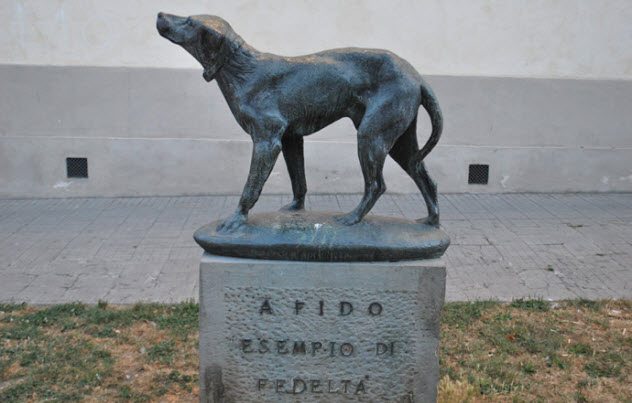
Many dogs who remain faithful to their dead masters only receive full recognition for their loyalty after death. Fido, an Italian dog whose name means “Faithful,” was one of the few honored during his lifetime. Pictures survive of Fido being shown the bronze statue erected in his honor.
Starting life as a stray on the street, Fido was adopted by Carlo Soriani in 1941. Soriani discovered Fido as a puppy trapped in a small gully and rescued him. Fido was true to his name and followed Soriani everywhere. Each morning, he would follow his master to the stop where Soriani caught his bus to work. Then Fido waited until Soriani returned from his factory job.[5]
All was well until December 1943 when an Allied bombing raid killed Soriani in his factory. Fido waited for the bus that evening, but his master never returned. Fido eventually went home to Soriani’s widow. But each evening for the next 14 years, the dog would return to the bus stop and wait for his master.
To honor the dog’s faithfulness, the town awarded him a gold medal, freedom from paying taxes, and a statue.
5 The Lapdog Of Mary, Queen Of Scots
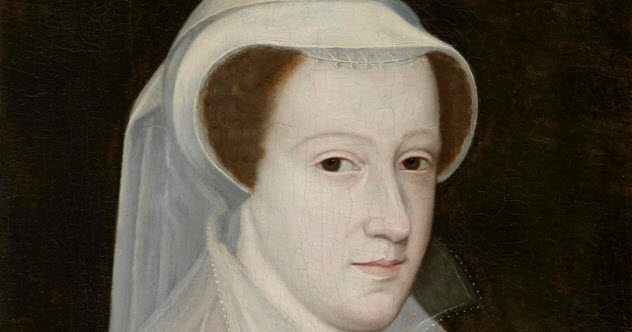
Mary, Queen of Scots, led a turbulent life. She became queen of Scotland at just six days old, was briefly the queen consort of France, and lost her own throne after returning to Scotland. Fleeing to England, she was held captive by her cousin, Queen Elizabeth I, because Mary’s Catholicism was a threat to Elizabeth’s rule.
One of the few constants in Mary’s life was the collection of small lapdogs that she had gained in France. During the long years of her captivity, it was said that Mary would speak to her dogs to stave off her loneliness.
Eventually, Queen Elizabeth signed Mary’s death warrant because plots were springing up to place Mary on the English throne. As Mary was led to the axeman’s block, no one noticed that she was not alone. Hiding underneath her skirts was one of her dogs.
When Mary’s head was cut off, her skirts were seen moving and the little dog crawled out. Covered in blood, the lapdog huddled in the gap between the queen’s body and her head. According to legend, the dog was only removed with difficulty and starved itself to death.[6]
4 Ruswarp
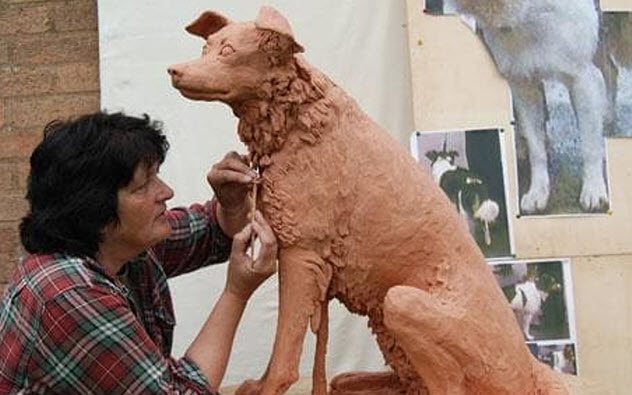
When Graham Nuttall did not return from his day of walking in the mountains of Wales, his friends raised the alarm. It was January 1990, and the weather was severe. Search parties spent a week looking, but they failed to find any sign of Nuttall or his dog, Ruswarp.
Eventually, the search was called off. Eleven weeks later, another walker stumbled on Nuttall’s body beside a stream. Ruswarp, weak and starving, was found beside him. After 11 weeks in the snow and rain while keeping vigil beside his owner, Ruswarp was so weak that he had to be carried down the mountain. He lived long enough to attend Nuttall’s funeral but died soon afterward.
In 2009, a bronze statue of Ruswarp was unveiled at a train station which Nuttall had been instrumental in reopening. Ruswarp had added his voice to a petition that saved the train station by placing his paw print beside the thousands of human signatures.[7]
3 Kostya
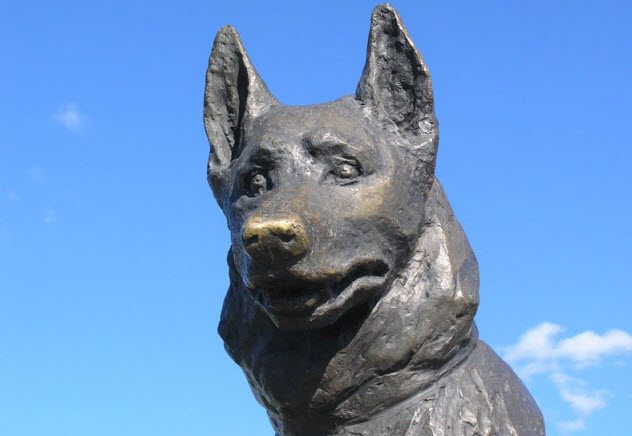
In the Russian city of Tolyatti, a dog could be seen waiting beside a busy road all day long. Despite the efforts of locals to find a new home for the dog, he would always return to his spot beside the road. When they began to investigate, they discovered that the dog had a tragic past.
The dog was waiting at the site of a car crash. A young girl had been killed instantly, and her father had died in the hospital from his injuries. The only survivor of the crash was their dog. For the dog’s loyalty to his owner, Tolyatti’s citizens started to call him Kostya (“Loyal”).[8]
Kostya stayed at his post for seven years looking for the return of his family. When he was found dead in the woods nearby, local people mourned. The city set up a statue of Kostya called “Loyalty.” Now, newlywed couples rub the statue’s nose in hopes of the spouses being as faithful to each other as Kostya was to his family.
2 Hachiko
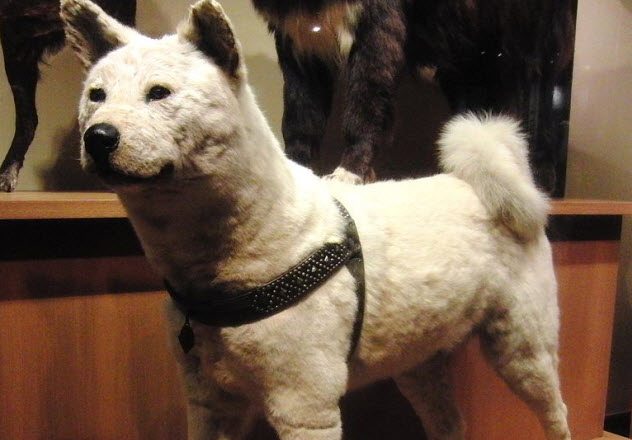
Hidesaburo Ueno was a professor of agricultural studies in Japan who wanted a rare Akita dog. Finally finding one, he adopted the dog in 1924 and called it Hachiko. The two soon became inseparable.
Each day, Hachiko would walk with Ueno to the train station. Then the dog would return in the evening to wait patiently for his master. Just one year after they had met each other, Ueno died suddenly while lecturing. Hachiko waited in vain beside the station for his owner.
People soon began to notice this faithful dog and would leave food and treats for Hachiko as rewards for his loyalty. The story of Hachiko spread, and his example of devotion was widely praised in Japan. With Hachiko present, a statue to the dog was unveiled in 1934.
When he died in 1935, Hachiko was mourned. A photo shows people gathered sadly around his body. The statue of Hachiko is a popular monument in Tokyo. Those wishing to get even closer to the dog can do so in the National Museum of Nature and Science in Tokyo where Hachiko is stuffed and on display.[9]
1 Greyfriars Bobby
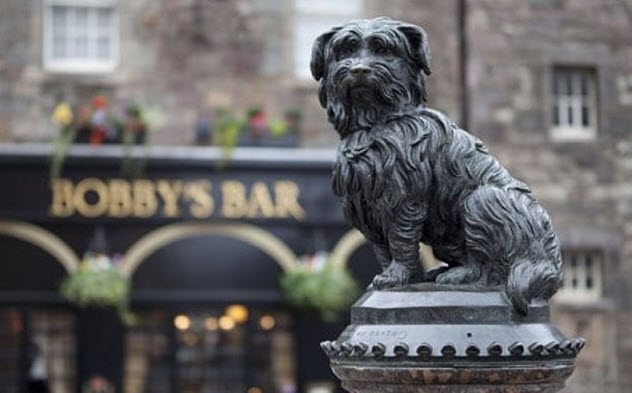
On the corner of Candlemaker Row in Edinburgh, tourists crowd around a small bronze statue of a dog to get a picture of it. Just across the road is Greyfriars Kirkyard, where the legend of Greyfriars Bobby came into being.
The traditional story is that John Gray, an Edinburgh policeman, had a terrier called Bobby that accompanied him on his rounds. When Gray died, he was buried in Greyfriars Kirkyard. However, Bobby would not be parted from his master.
Despite the best efforts of the graveyard keeper, the dog would not leave. Eventually, people came specifically to see Bobby keeping guard next to Gray’s grave. When Bobby died after a 14-year vigil, he was buried close to his master in the kirkyard and given a gravestone that reads: “Greyfriars Bobby—died 14th January 1872—aged 16 years—Let his loyalty and devotion be a lesson to us all.”[10]
Of course, there are those who cast doubt on the story. One researcher has claimed that the staff tending the churchyard lured a dog to the grave with food and spread the rumor of his loyalty to encourage visitors. Pubs near the churchyard profited from the increased attention.
It has even been suggested that when one “Bobby” died, it was replaced with a similar dog to keep the Bobby business going. But that’s a depressing idea. Most people prefer to believe the idea of the faithful dog.
For more heartwarming tales of dogs, check out 10 Incredible Rescues By Dogs That Will Warm Your Heart and 10 Incredible Stories Of Heroic Dogs Of War.


